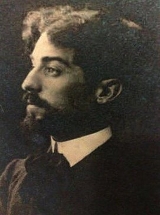U.Porto Memory
University of Porto Famous Alumni
António Alves de Sousa
 |
António Alves de Sousa 1884-1922 Sculptor |
 Born in Vilar de Andorinho, Vila Nova de Gaia, on 9 January 1884, António Alves de Sousa was the son of Joaquim de Sousa, a stonemason, and Felicidade Francisca Alves, a seamstress.
Born in Vilar de Andorinho, Vila Nova de Gaia, on 9 January 1884, António Alves de Sousa was the son of Joaquim de Sousa, a stonemason, and Felicidade Francisca Alves, a seamstress.
He was actively involved in helping his father in his work and revealed, from a very early stage, a particular talent for sculpture.
In 1897, Alves de Sousa was admitted to the Porto Academy of Fine Arts, and concluded his studies in Sculpture in 1905 with an excellent final mark of 18 out of 20. At the Academy, this extraordinary follower of the Gaia School of Sculpture was much praised by masters and colleagues, namely by Professor António Teixeira Lopes, by his fellow Pinto do Couto and João Chagas.
After completing his studies, Alves de Sousa soon began to exhibit his work, for instance the work entitled Uma mulher do povo conduzindo duas crianças, cai debilitada pela fome em um banco de praça pública (a common woman leading two children falls onto a public bench, suffering from starvation), which met a favourable public reaction, both by the art experts and the public in general.
In 1907, the sculptor competed for a grant in the field of Sculptor studies in Paris with fellow sculptors Rodolfo Pinto do Couto and José de Oliveira Ferreira, who was eventually awarded the scholarship. Although Paris was, at the time, hallmark for the European plastic artists, Alves de Sousa was not discouraged by the fact that he did not receive the grant and, in 1908, together with Pinto do Couto, applied once again to the scholarship. This time he won the competition with the sculpture Escravo romano sucumbindo ao veneno (Roman slave finally overcome by the poison), which was once again applauded by the experts.
![]() In 1909, he left for Paris, where he married and raised his children. In that same year, together with architect Marques da Silva, he took part in the contest for the monument entitled Monumento aos mortos da Guerra Peninsular (Memorial to the Dead of the Peninsular War), to be erected in Porto. As he had left for Paris, the figures for the monument would have to be done in the French capital, which was not materialized as the sculptor died in the meantime. Years later, this work was taken up by artists Sousa Caldas and Henrique Moreira
In 1909, he left for Paris, where he married and raised his children. In that same year, together with architect Marques da Silva, he took part in the contest for the monument entitled Monumento aos mortos da Guerra Peninsular (Memorial to the Dead of the Peninsular War), to be erected in Porto. As he had left for Paris, the figures for the monument would have to be done in the French capital, which was not materialized as the sculptor died in the meantime. Years later, this work was taken up by artists Sousa Caldas and Henrique Moreira
In 1914, in another partnership with Marques da Silva, Alves de Sousa competed for the Monumento dedicado ao Marquês de Pombal (a monument dedicated to the Marquis of Pombal), in Lisboa, which was nevertheless won by Francisco dos Santos. Far from being consensual, this decision was controversial and encouraged flaming debates. António Arroio and Guerra Junqueiro, among others, preferred that the project be done by the two artists from the north of the country.
Upon his return from Paris, Alves de Sousa brought with him his two motherless young children, together with a number of art works which, after his death, were purchased from his family by the National Museum Soares dos Reis, in Porto, where they are now being showcased (they include various sculptures, and portraits, such asGaroto dos jornais, Desespero, A Mãe de Jesus Cristo, Vítimas da Miséria, Estudo académico, Orfeu, Cristo preso à coluna (1911), Retrato do escultor Pinto de Couto, Avant l’opération, Procissão de Fome, Sousanne Bouré, Bacante, three works on Orpheus and a final experiment on Oedipus and Antigone, which he sent to the School of Fine Arts).
 Alves de Sousa, described as having a romantic temperament, died prematurely and in great suffering at the age of 38, on 5 March 1922, from consumption, which had led him to the point of madness.
Alves de Sousa, described as having a romantic temperament, died prematurely and in great suffering at the age of 38, on 5 March 1922, from consumption, which had led him to the point of madness.
(Universidade Digital / Gestão de Informação, 2009)
Last updated: 2016-01-05 Webpage created on: 2024-05-11 09:13:40 Complaint Portal